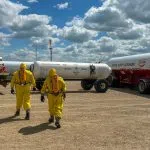
Future unclear for wildfire evacuees from Pelican Narrows
Tired and hungry after a near six-hour bus trip, a group of evacuees from Pelican Narrows arrived at the Prince Albert Grand Council Urban Services building in Prince Albert, knowing it won’t be long before they have to re-board and venture further away from home.
Roughly 1,300 band members are part of the initial evacuation order which includes Elders and young children. Cory McCallum said the smoke back home is pretty bad.
“It was pretty scary with all the dark smoke all around Pelican Narrows,” he explained.
The group’s stop over in Prince Albert is short, as they will be staying at a hotel in Saskatoon. This is due to a shortage of available rooms in Prince Albert.




